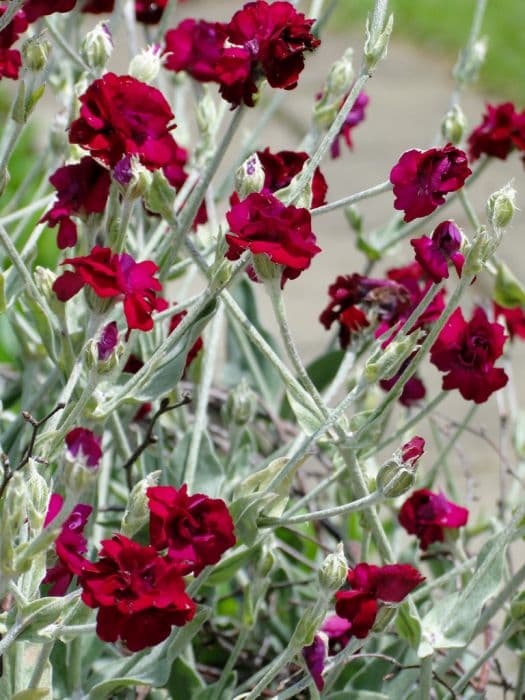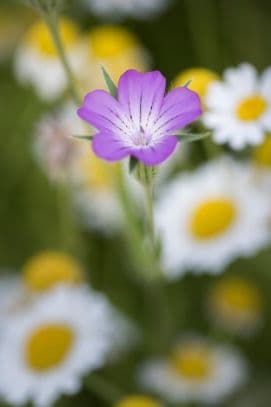Soapwort Saponaria ocymoides

ABOUT
The plant, commonly known as rock soapwort, is a perennial herb that is noted for its lush foliage and vibrant flowering habit. The leaves are small, oval-shaped, and have a glossy green appearance, contributing to the plant’s overall dense and mat-forming characteristics. Throughout the bloom season, rock soapwort becomes adorned with an abundance of dainty, five-petaled flowers which exhibit a vivacious pink hue, often described as a lively magenta or bright pink tone, adding a spark of color that is especially eye-catching. The blossoms of the rock soapwort tend to cluster at the tips of the stems, creating an attractive and frothy display that can give a slightly ruffled texture to the plant’s profile. These flowers exude a delicate, sweet fragrance that can be quite noticeable, especially during the evening or when planted in large swaths. Overall, rock soapwort is cherished in garden settings for its showy floral display and its capability to form a carpet-like ground cover, which offers a charming effect when draped over rocks or used to soften the edges of garden pathways.
About this plant
 Names
NamesFamily
Caryophyllaceae.
Synonyms
Rock Soapwort, Tumbling Ted, Rock-Soapwort, Creeping Pink, Soapwort, Bouncing Bet, Roving Sailor, Tumbling Ted Soapwort.
Common names
Bootia ocymoides, Lychnis ocymoides, Saponaria caespitosa, Silene ocymoides.
 Toxicity
ToxicityTo humans
The common name for Saponaria ocymoides is Rock Soapwort. It contains saponins, which are toxic compounds that can be harmful if ingested in significant quantities. If parts of Rock Soapwort are ingested, the saponins may cause irritation to the mucous membranes, leading to symptoms like nausea, vomiting, and diarrhea. Ingesting large amounts could potentially result in more severe digestive upset, but the plant is not generally considered highly toxic to humans.
To pets
For pets, Rock Soapwort can also be toxic. Similar to humans, the saponins can cause irritation in the gastrointestinal tract if ingested, leading to symptoms such as vomiting, diarrhea, and abdominal pain. It is important to prevent pets from ingesting this plant to avoid these adverse health effects. While it is not typically fatal, consuming large quantities of Rock Soapwort could lead to more serious complications, so it is best to keep pets away from the plant.
 Characteristics
CharacteristicsLife cycle
Perennials
Foliage type
Semi-deciduous
Color of leaves
Green
Flower color
Pink
Height
6-12 inches (15-30 cm)
Spread
12-24 inches (30-60 cm)
Plant type
Herb
Hardiness zones
3-8
Native area
Europe
Benefits
 General Benefits
General Benefits- Attractive Ground Cover: Saponaria ocymoides, commonly known as rock soapwort, spreads quickly to form dense mats of foliage that can cover large areas and suppress weeds.
- Easy to Grow: It's undemanding and can thrive in a variety of soil conditions, including poor soils, making it ideal for novice gardeners.
- Aesthetic Appeal: Rock soapwort produces a profusion of pink flowers that can add a splash of color to rock gardens, borders, or slopes.
- Drought Tolerance: Once established, Saponaria ocymoides is drought-resistant, making it suitable for xeriscaping and low-water gardens.
- Pollinator Attraction: The flowers are frequented by bees, butterflies, and other pollinators, supporting local ecosystems.
- Erosion Control: Its dense root system helps stabilize soil on slopes and embankments, preventing erosion.
- Low Maintenance: Rock soapwort requires minimal care once established, with no need for regular watering, fertilizing, or pruning.
- Deer Resistance: This plant is generally resistant to deer, making it a good choice for areas with a large deer population.
- Seasonal Interest: Saponaria ocymoides has a long flowering period from late spring to summer, offering visual interest throughout the season.
- Versatility: It can be used in a variety of garden settings, from a traditional flower bed to a rock or alpine garden.
 Medical Properties
Medical Properties- Antitussive: Saponaria ocymoides may have properties that can help relieve coughs.
- Expectorant: The saponins present may aid in loosening mucus in the airways, facilitating easier expectoration.
 Air-purifying Qualities
Air-purifying QualitiesThis plant is not specifically known for air purifying qualities.
 Other Uses
Other Uses- Saponaria ocymoides, commonly known as "rock soapwort," has been traditionally used as a soap alternative due to its saponin content which creates a lather when mixed with water.
- The frothy liquid from the plant was once used for cleaning delicate or antique textiles that might be damaged by harsh chemicals.
- Rock soapwort can be planted on slopes or banks for erosion control as it spreads quickly, providing ground cover that stabilizes soil.
- It has been used as a natural dye for fabrics, yielding a range of subtle tones depending on the mordant used.
- Gardeners use rock soapwort as an ornamental plant to create a "spillover" effect in rock gardens and wall crevices, where it cascades beautifully.
- The plant is favored in butterfly gardens as it attracts pollinators with its plentiful pink flowers.
- Rock soapwort is sometimes included in "green roofing" due to its drought tolerance and ability to thrive in poor soils.
- When dried, the leaves and stems of the plant have been used in potpourris for their light, pleasant scent.
- The plant's dense groundcover capability makes it a natural weed suppressant by preventing light from reaching potential weed seedlings.
- In some regions, the plant has been used to stabilize stream banks and prevent runoff into waterways.
Interesting Facts
 Feng Shui
Feng ShuiThe Rock Soapwort is not used in Feng Shui practice.
 Zodiac Sign Compitability
Zodiac Sign CompitabilityThe Rock Soapwort is not used in astrology practice.
 Plant Symbolism
Plant Symbolism- Purity: Saponaria ocymoides, commonly known as "rock soapwort," has cleaning properties due to its saponin content, symbolizing purity and the removal of negative influences.
- Everlasting Love: The perennial nature of rock soapwort and its capacity to spread and cover ground might represent enduring love that continues to grow.
- Survival and Adaptation: As it can thrive in rocky, challenging environments, rock soapwort symbolizes resilience, survival, and the ability to adapt to difficult circumstances.
- Protection: The saponins found in the plant can create a lather and were traditionally used for cleansing, symbolically providing protection from harm and negative energies.
 Water
WaterRock Soapwort prefers consistent moisture, but it is also important to avoid overwatering. During the growing season, water the plant about once a week, providing enough water to moisten the soil to a depth of about an inch. If you're using a container, ensure that excess water can drain to prevent waterlogging. In periods of drought, you may need to water more frequently. Less water is required during the winter months when the plant is dormant; watering every two to three weeks should be sufficient, depending on the humidity levels of your environment. Use about half a gallon for outdoor plants and adjust accordingly for smaller, potted specimens.
 Light
LightRock Soapwort thrives in full sun to partial shade. It is best to plant it in a location that receives at least six hours of direct sunlight daily to ensure robust growth and optimal flowering. If you're planting indoors, a south-facing window is an ideal spot to provide the ample light that Rock Soapwort needs.
 Temperature
TemperatureThe ideal temperature range for Rock Soapwort is between 60 and 75 degrees Fahrenheit. It is hardy and can tolerate temperatures down to about 30 degrees Fahrenheit without significant damage, and it can withstand summer temperatures as high as 90 degrees Fahrenheit. However, for optimal growth, keeping it within the ideal temperature range is advisable.
 Pruning
PruningPruning Rock Soapwort is necessary to maintain its shape, encourage bushier growth, and remove spent flowers to extend the blooming season. The best time for pruning is immediately after the plant finishes its main flush of blooming, usually in early summer. At this time, cut the stems back by about one-third to promote new growth and additional flowering. A light trim in the fall can also help maintain tidiness throughout the winter.
 Cleaning
CleaningAs needed
 Soil
SoilRock soapwort, Saponaria ocymoides, thrives best in a well-draining soil mix with a pH ranging from 6.0 to 7.5. A mixture of loamy soil with added perlite or coarse sand enhances drainage. Incorporating organic matter, like compost, ensures balanced nutrition.
 Repotting
RepottingRock soapwort is a low-maintenance plant that typically does not require frequent repotting. Repotting every 2 to 3 years, or when it outgrows its current container, is sufficient to maintain its health.
 Humidity & Misting
Humidity & MistingRock soapwort is adaptable and does not require specific humidity conditions. As a hardy plant, it can tolerate the humidity levels typically found in most outdoor garden environments.
 Suitable locations
Suitable locationsIndoor
Ensure bright light, minimal watering, and good air circulation for indoor Rock soapwort.
Outdoor
Plant Rock soapwort in full sun, well-draining soil, and space for spreading.
Hardiness zone
3-8 USDA
 Life cycle
Life cycleSaponaria ocymoides, commonly known as Rock Soapwort, begins its life cycle as a seed, which upon finding suitable conditions germinates to produce a small seedling. The seedling then develops into a vegetative stage, forming a low, spreading mound of bright green leaves. As it matures, Rock Soapwort enters the flowering stage, typically in late spring to early summer, showcasing dense clusters of pink, star-shaped flowers. After pollination, often aided by insects, the plant sets seed within small capsules, which then dry and release the seeds to complete the reproductive cycle. During the winter, it may die back, especially in colder climates, but it's a perennial, and thus it regrows from the root system as the weather warms. Throughout its life, Rock Soapwort spreads both by self-seeding and vegetatively through its root system, enabling the formation of larger colonies or groundcover.
 Propogation
PropogationPropogation time
Spring-Early Summer
Propogation: Soapwort, known botanically as Saponaria ocymoides, can best be propagated through softwood cuttings, which is a popular and effective method for this plant. This technique typically takes place in the late spring or early summer when new growth is soft and pliable. To propagate by cuttings, one would select a healthy piece of new growth, usually about 4 to 6 inches (10 to 15 centimeters) long, and cut it just below a leaf node. It is beneficial to remove the lower leaves and dip the cut end in rooting hormone to encourage root development. The cutting should then be placed in a pot with well-draining soil, ensuring the remaining leaves are not buried. Keeping the soil consistently moist and providing indirect light will aid in the rooting process, which can take several weeks. Once roots have established, the plant can be transplanted to its final location.








